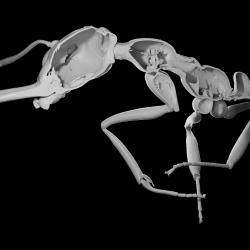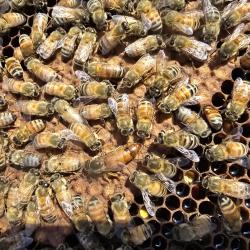Four College Faculty Members Named 2017 Highly Cited Researchers
Published works by Sankar Das Sarma, Ian Spielman, Jacob Taylor and Dennis vanEngelsdorp have consistently been judged by their peers to be of particular use and significance
Four faculty members in the University of Maryland’s College of Computer, Mathematical, and Natural Sciences are included on Clarivate Analytics’ 2017 list of Highly Cited Researchers, a compilation of influential names in science.
- Sankar Das Sarma, Richard E. Prange Chair in Physics, Distinguished University Professor, Joint Quantum Institute (JQI) Fellow and Condensed Matter Theory Center Director. Das Sarma was included in all previous compilations of this list in 2016, 2015, 2014 and 2001.
- Ian Spielman, Adjunct Professor of Physics, JQI Fellow and National Institute of Standards and Technology (NIST) Physicist.
- Jacob Taylor, Adjunct Associate Professor of Physics and Co-director of the Joint Center for Quantum Information and Computer Science (QuICS). Taylor is also a NIST Physicist and a JQI Fellow.
- Dennis vanEngelsdorp, Assistant Professor of Entomology and Project Director for the Bee Informed Partnership. VanEngelsdorp was also included in the 2016 compilation.
Das Sarma’s research interests include condensed matter physics, statistical mechanics and quantum information. A theoretical condensed matter physicist, Das Sarma has worked in the areas of strongly correlated materials, graphene, semiconductor physics, low-dimensional systems, topological matter, quantum Hall effect, nanoscience, spintronics, collective properties of ultra-cold atomic and molecular systems, optical lattice, many-body theory, Majorana fermion, and quantum computation. In 2005, Das Sarma, with colleagues Chetan Nayak and Michael Freedman of Microsoft Research, introduced the nu=5/2 topological qubit that led to experiments in building a fault-tolerant quantum computer based on two-dimensional semiconductor structures.
Das Sarma, a physics faculty member at UMD since 1980, earned his undergraduate degree in physics in 1973 from Presidency College in Kolkata, India, and his Ph.D. in theoretical condensed physics in 1979 from Brown University.
Spielman studies the Bose-Hubbard model for ultra-cold rubidium atoms in an optical lattice and magneto-optical configurations that can make charge-neutral bosons move like-charged particles in a magnetic field. Both topics have applications in quantum computing. He also works on constructing a hybrid Bose-Fermi experiment to study fermions and mixtures of fermions and bosons in optical lattices, which have applications in high-temperature superconductivity.
Spielman earned his undergraduate degree in physics and mathematics from the University of Oklahoma in 1998 and his Ph.D. in physics from the California Institute of Technology in 2004.
Taylor researches the fundamental and practical limits to building quantum information devices; novel approaches to entangling atomic, photonic and solid-state systems; and potential applications of quantum information systems in metrology and measurement science. In 2014, Taylor became co-director of QuICS, where experts in areas including computer science, cybersecurity, mathematics and physics collaborate with postdoctoral scholars, graduate students and visitors to form a robust research community that is advancing quantum computer science and quantum information theory.
Taylor earned his undergraduate degrees in astronomy and physics in 2000 from Harvard University, where he also earned his Ph.D. in physics in 2006.
VanEngelsdorp’s research focuses on using an epidemiological approach to assess honey bee health. His research group is a world leader in the study of major mechanisms responsible for the decline in honey bee health, including an increase in pests and pathogens, poor nutrition due to the loss of natural forage and pesticides applied by both beekeepers and farmers. VanEngelsdorp’s approach is multifaceted, addressing both the etiology of individual bee diseases and the large-scale monitoring of colony health. He is also the founding president of the Bee Informed Partnership Inc., a not for profit dedicated to funding honey bee surveillance systems with the intent of reducing honey bee colony losses. In combination with annual nationwide surveys, the Bee Informed Partnership also works directly with beekeepers to help gather pest and disease data and validate trends in management practices.
VanEngelsdorp earned his undergraduate degree in agriculture in 1992 and his master’s degree in environmental biology in 1995 from the University of Guelph in Ontario, Canada, and his Ph.D. from the Pennsylvania State University in 2011.
The Highly Cited Researchers list features more than 3,300 authors from 21 science disciplines whose published work in their specialty areas has consistently been judged by their peers to be of particular use and significance. These researchers earned the distinction by writing the greatest numbers of reports officially designated by Essential Science Indicators (ESI) as Highly Cited Papers—ranking among the top 1 percent most cited for their subject field and year of publication. The 2017 Highly Cited Researchers list is drawn from data contained in the ESI spanning 2005-2015.
The Highly Cited Researchers list is one of several criteria used by the Center for World-Class Universities at Shanghai Jiao Tong University to determine the Academic Ranking of World Universities.
###
Media Relations Contact: Irene Ying, 301-405-5204, zying@umd.edu
University of Maryland
College of Computer, Mathematical, and Natural Sciences
2300 Symons Hall
College Park, MD 20742
www.cmns.umd.edu
@UMDscience
About the College of Computer, Mathematical, and Natural Sciences
The College of Computer, Mathematical, and Natural Sciences at the University of Maryland educates more than 7,000 future scientific leaders in its undergraduate and graduate programs each year. The college’s 10 departments and more than a dozen interdisciplinary research centers foster scientific discovery with annual sponsored research funding exceeding $150 million.







